Quantum-Well-Embedded InGaN Quantum Dot Vertical-Cavity Surface-Emitting Laser and Its Photoelectric Performance
Abstract
:1. Introduction
2. VCSEL Device Design
3. Simulation Results Analysis
3.1. Energy Band Diagram of the Active Region
3.2. Recombination Analysis
3.3. Optical Mode
4. Conclusions
Author Contributions
Funding
Institutional Review Board Statement
Informed Consent Statement
Data Availability Statement
Acknowledgments
Conflicts of Interest
References
- Liu, A.; Wolf, P.; Lott, J.A.; Bimberg, D. Vertical-cavity surface-emitting lasers for data communication and sensing. Photonics Res. 2019, 7, 121–136. [Google Scholar] [CrossRef]
- Weigl, B.; Grabherr, M.; Jung, C.; Jager, R.; Reiner, G.; Michalzik, R.; Sowada, D.; Ebeling, K.J. High-performance oxide-confined GaAs VCSELs. IEEE J. Sel. Top. Quantum Electron. 1997, 3, 409–415. [Google Scholar] [CrossRef]
- Zhang, C.; ElAfandy, R.; Han, J. Distributed Bragg reflectors for GaN-based vertical-cavity surface-emitting lasers. Appl. Sci. 2019, 9, 1593. [Google Scholar] [CrossRef]
- Yu, H.-C.; Zheng, Z.-w.; Mei, Y.; Xu, R.-B.; Liu, J.-P.; Yang, H.; Zhang, B.-P.; Lu, T.-C.; Kuo, H.-C. Progress and prospects of GaN-based VCSEL from near UV to green emission. Prog. Quantum Electron. 2018, 57, 1–19. [Google Scholar] [CrossRef]
- Rambu, A.P.; Tiron, V.; Oniciuc, E.; Tascu, S. Spontaneous Polarization Reversal Induced by Proton Exchange in Z-Cut Lithium Niobate α-Phase Channel Waveguides. Materials 2021, 14, 7127. [Google Scholar] [CrossRef]
- Ahmad, A.; Strak, P.; Koronski, K.; Kempisty, P.; Sakowski, K.; Piechota, J.; Grzegory, I.; Wierzbicka, A.; Kryvyi, S.; Monroy, E. Critical evaluation of various spontaneous polarization models and induced electric fields in III-nitride multi-quantum wells. Materials 2021, 14, 4935. [Google Scholar] [CrossRef]
- Solís-Cisneros, H.I.; Hu, Y.; Camas-Anzueto, J.L.; Grajales-Coutiño, R.; Anwar, A.-R.; Martínez-Revuelta, R.; Hernández-de-León, H.R.; Hernández-Gutiérrez, C.A. theoretical and computational analysis of a wurtzite-AlGaN DUV-LED to mitigate quantum-confined Stark effect with a zincblende comparison considering Mg-and Be-doping. Nanomaterials 2022, 12, 4347. [Google Scholar] [CrossRef]
- Hautier, G.; Miglio, A.; Ceder, G.; Rignanese, G.-M.; Gonze, X. Identification and design principles of low hole effective mass p-type transparent conducting oxides. Nat. Commun. 2013, 4, 2292. [Google Scholar] [CrossRef]
- Binks, D.; Dawson, P.; Oliver, R.; Wallis, D. Cubic GaN and InGaN/GaN quantum wells. Appl. Phys. Rev. 2022, 9, 041309. [Google Scholar] [CrossRef]
- Wu, X.G.; Jing, Y.; Zhong, H. In Situ Fabricated Perovskite Quantum Dots: From Materials to Applications. Adv. Mater. 2024, 2412276. [Google Scholar] [CrossRef]
- Lin, Y.-S.; Ma, K.-J.; Hsu, C.; Feng, S.-W.; Cheng, Y.-C.; Liao, C.-C.; Yang, C.; Chou, C.-C.; Lee, C.-M.; Chyi, J.-I. Dependence of composition fluctuation on indium content in InGaN/GaN multiple quantum wells. Appl. Phys. Lett. 2000, 77, 2988–2990. [Google Scholar] [CrossRef]
- Yuan, H.; Chen, Y.; Lin, R.; Tan, D.; Zhang, J.; Wang, Y.; Gazit, E.; Ji, W.; Yang, R. Modified Stranski–Krastanov growth of amino acid arrays toward piezoelectric energy harvesting. ACS Appl. Mater. Interfaces 2022, 14, 46304–46312. [Google Scholar] [CrossRef] [PubMed]
- Barettin, D. State of the Art of Continuous and Atomistic Modeling of Electromechanical Properties of Semiconductor Quantum Dots. Nanomaterials 2023, 13, 1820. [Google Scholar] [CrossRef] [PubMed]
- Muziol, G.; Turski, H.; Siekacz, M.; Szkudlarek, K.; Janicki, L.; Baranowski, M.; Zolud, S.; Kudrawiec, R.; Suski, T.; Skierbiszewski, C. Beyond quantum efficiency limitations originating from the piezoelectric polarization in light-emitting devices. Acs Photonics 2019, 6, 1963–1971. [Google Scholar] [CrossRef]
- Jiang, K.; Sun, X.; Shi, Z.; Zang, H.; Ben, J.; Deng, H.-X.; Li, D. Quantum engineering of non-equilibrium efficient p-doping in ultra-wide band-gap nitrides. Light Sci. Appl. 2021, 10, 69. [Google Scholar] [CrossRef]
- Barettin, D.; Sakharov, A.V.; Tsatsulnikov, A.F.; Nikolaev, A.E.; Pecchia, A.; auf Der Maur, M.; Karpov, S.Y.; Cherkashin, N. Impact of local composition on the emission spectra of InGaN quantum-dot LEDs. Nanomaterials 2023, 13, 1367. [Google Scholar] [CrossRef]
- Abbas, M.; Xu, X.; Rauf, M.; Kyaw, A.K.K. A Comprehensive Review on Defects-Induced Voltage Losses and Strategies toward Highly Efficient and Stable Perovskite Solar Cells. In Proceedings of the Photonics, Rome, Italy, 10–14 November 2024; p. 87. [Google Scholar]
- Ji, L.; Su, Y.-K.; Chang, S. InGaN/GaN multi-quantum dot light-emitting diodes. Phys. Status Solidi C 2004, 1, 2405–2408. [Google Scholar] [CrossRef]
- Zhang, M.; Banerjee, A.; Lee, C.-S.; Hinckley, J.M.; Bhattacharya, P. A InGaN/GaN quantum dot green (λ = 524 nm) laser. Appl. Phys. Lett. 2011, 98, 221104. [Google Scholar] [CrossRef]
- Weng, G.; Mei, Y.; Liu, J.; Hofmann, W.; Ying, L.; Zhang, J.; Bu, Y.; Li, Z.; Yang, H.; Zhang, B. Low threshold continuous-wave lasing of yellow-green InGaN-QD vertical-cavity surface-emitting lasers. Opt. Express 2016, 24, 15546–15553. [Google Scholar] [CrossRef]
- Mei, Y.; Weng, G.-E.; Zhang, B.-P.; Liu, J.-P.; Hofmann, W.; Ying, L.-Y.; Zhang, J.-Y.; Li, Z.-C.; Yang, H.; Kuo, H.-C. Quantum dot vertical-cavity surface-emitting lasers covering the ‘green gap’. Light: Sci. Appl. 2017, 6, e16199. [Google Scholar] [CrossRef]
- Usman, M.; Munsif, M.; Mushtaq, U.; Anwar, A.-R.; Muhammad, N. Green gap in GaN-based light-emitting diodes: In perspective. Crit. Rev. Solid State Mater. Sci. 2021, 46, 450–467. [Google Scholar] [CrossRef]
- Yang, T.; Chen, Y.-H.; Wang, Y.-C.; Ou, W.; Ying, L.-Y.; Mei, Y.; Tian, A.-Q.; Liu, J.-P.; Guo, H.-C.; Zhang, B.-P. Green vertical-cavity surface-emitting lasers based on InGaN quantum dots and short cavity. Nano-Micro Lett. 2023, 15, 223. [Google Scholar] [CrossRef] [PubMed]
- Hsu, T.-C.; Teng, Y.-T.; Yeh, Y.-W.; Fan, X.; Chu, K.-H.; Lin, S.-H.; Yeh, K.-K.; Lee, P.-T.; Lin, Y.; Chen, Z. Perspectives on UVC LED: Its progress and application. In Proceedings of the Photonics, Vancouver, BC, Canada, 18–21 October 2021; p. 196. [Google Scholar]
- Song, J.; Luo, Z.; Liu, X.; Li, E.; Jiang, C.; Huang, Z.; Li, J.; Guo, X.; Ding, Z.; Wang, J. The study on structural and photoelectric properties of zincblende InGaN via first principles calculation. Crystals 2020, 10, 1159. [Google Scholar] [CrossRef]
- Xu, R.; Akiyama, H.; Zhang, B. Impacts of SiO2-Buried Structure on Performances of GaN-Based Vertical-Cavity Surface-Emitting Lasers. IEEE Trans. Electron Devices 2023, 70, 5701–5706. [Google Scholar] [CrossRef]
- Duzgol, O.; Kyritsis, G.; Zakhleniuk, N. Travelling-wave modelling of the modulation dynamic performance of wavelength-tunable laser diodes using the integrated VPI and PICS3D software. IET Optoelectron. 2017, 11, 66–72. [Google Scholar] [CrossRef]
- Ho, C.-H.; Speck, J.S.; Weisbuch, C.; Wu, Y.-R. Efficiency and forward voltage of blue and green lateral LEDs with V-shaped defects and random alloy fluctuation in quantum wells. Phys. Rev. Appl. 2022, 17, 014033. [Google Scholar] [CrossRef]
- Heikman, S.; Keller, S.; Wu, Y.; Speck, J.S.; DenBaars, S.P.; Mishra, U.K. Polarization effects in AlGaN/GaN and GaN/AlGaN/GaN heterostructures. J. Appl. Phys. 2003, 93, 10114–10118. [Google Scholar] [CrossRef]
- Sun, H.; Park, Y.J.; Li, K.-H.; Liu, X.; Detchprohm, T.; Zhang, X.; Dupuis, R.D.; Li, X. Nearly-zero valence band and large conduction band offset at BAlN/GaN heterointerface for optical and power device application. Appl. Surf. Sci. 2018, 458, 949–953. [Google Scholar] [CrossRef]
- Hsieh, F.-J.; Wang, W.-C. Full extraction methods to retrieve effective refractive index and parameters of a bianisotropic metamaterial based on material dispersion models. J. Appl. Phys. 2012, 112, 064907. [Google Scholar] [CrossRef]
- Ruiz, N.; Fernández, D.; Stanojević, L.; Ben, T.; Flores, S.; Braza, V.; Carro, A.G.; Luna, E.; Ulloa, J.M.; González, D. Suppressing the effect of the wetting layer through AlAs capping in InAs/GaAs QD structures for solar cells applications. Nanomaterials 2022, 12, 1368. [Google Scholar] [CrossRef]
- Althib, H. Effect of quantum barrier width and quantum resonant tunneling through InGaN/GaN parabolic quantum well-LED structure on LED efficiency. Results Phys. 2021, 22, 103943. [Google Scholar] [CrossRef]
- Kim, Y.-S.; Marsman, M.; Kresse, G.; Tran, F.; Blaha, P. Towards efficient band structure and effective mass calculations for III-V direct band-gap semiconductors. Phys. Rev. B—Condens. Matter Mater. Phys. 2010, 82, 205212. [Google Scholar] [CrossRef]
- Zhang, Y.; Li, Y.; Xin, X.; Wang, Y.; Guo, P.; Wang, R.; Wang, B.; Huang, W.; Sobrido, A.J.; Li, X. Internal quantum efficiency higher than 100% achieved by combining doping and quantum effects for photocatalytic overall water splitting. Nat. Energy 2023, 8, 504–514. [Google Scholar] [CrossRef]
- Baten, M.Z.; Alam, S.; Sikder, B.; Aziz, A. III-nitride light-emitting devices. Photonics 2021, 8, 430. [Google Scholar] [CrossRef]
- Zhao, L.; Liu, C.; Wang, K. Progress of GaN-Based Optoelectronic Devices Integrated with Optical Resonances. Small 2022, 18, 2106757. [Google Scholar] [CrossRef]
- Xu, R.; Mei, Y.; Xu, H.; Yang, T.; Ying, L.; Zheng, Z.; Long, H.; Zhang, B.; Liu, J. Effects of lateral optical confinement in GaN VCSELs with double dielectric DBRs. IEEE Photonics J. 2020, 12, 1–8. [Google Scholar] [CrossRef]
- Andreoli, F.; Gullans, M.J.; High, A.A.; Browaeys, A.; Chang, D.E. Maximum refractive index of an atomic medium. Phys. Rev. X 2021, 11, 011026. [Google Scholar] [CrossRef]
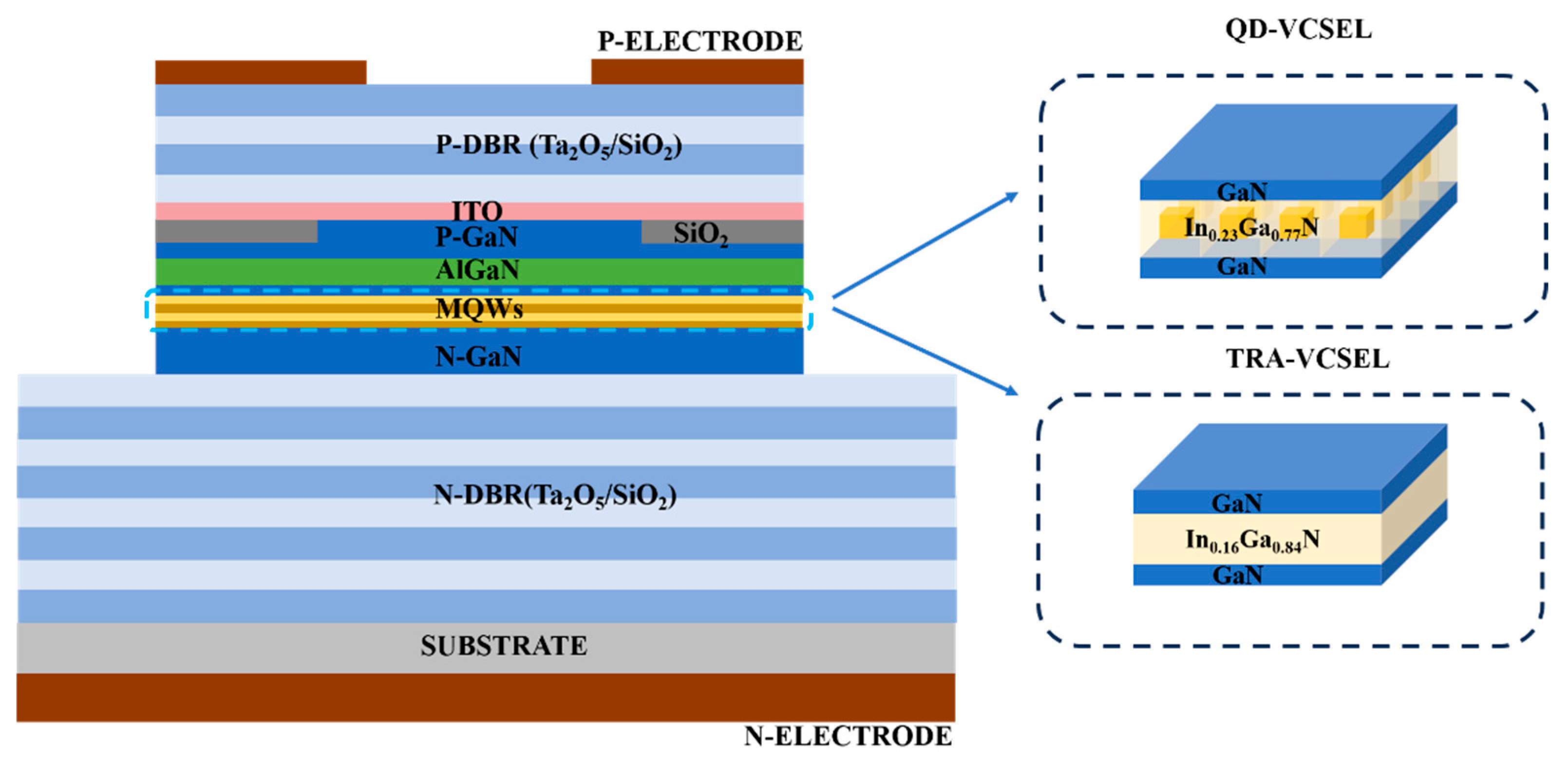
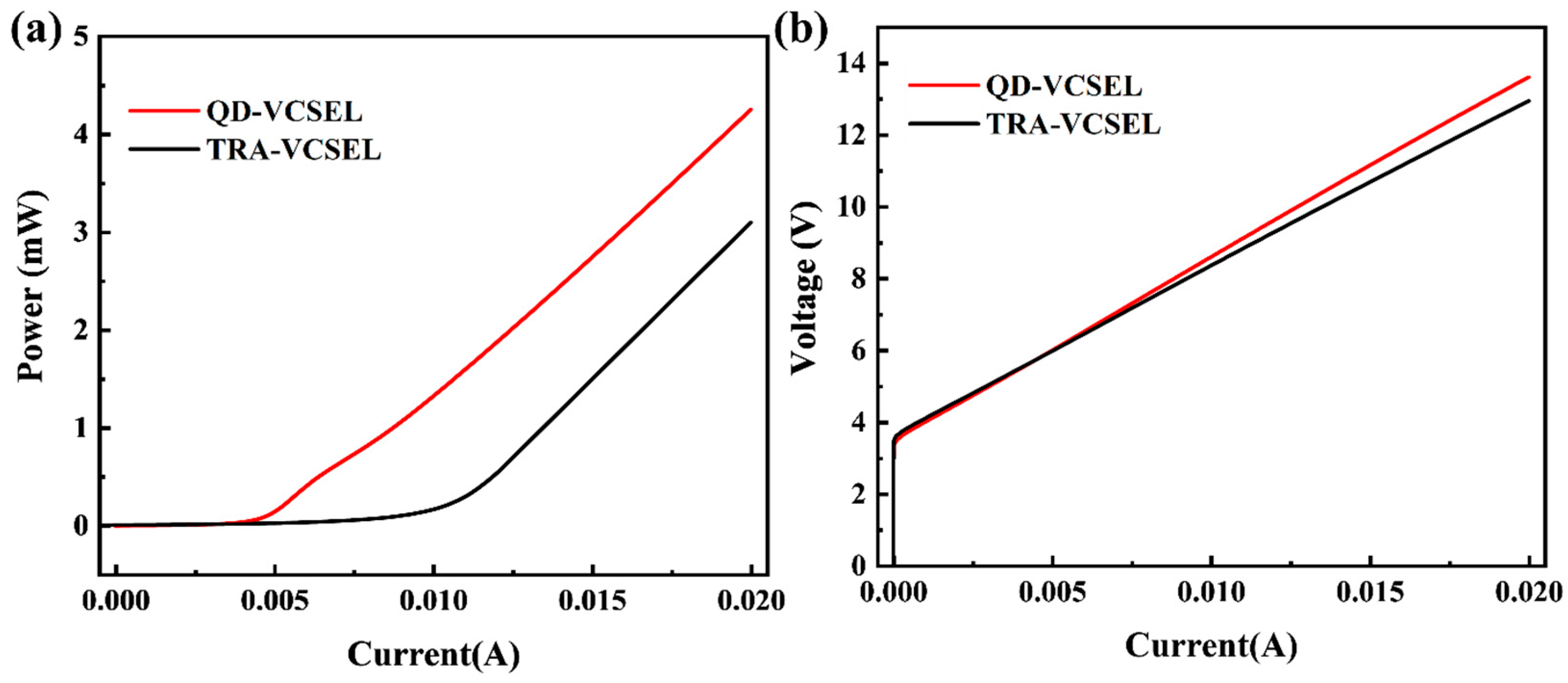

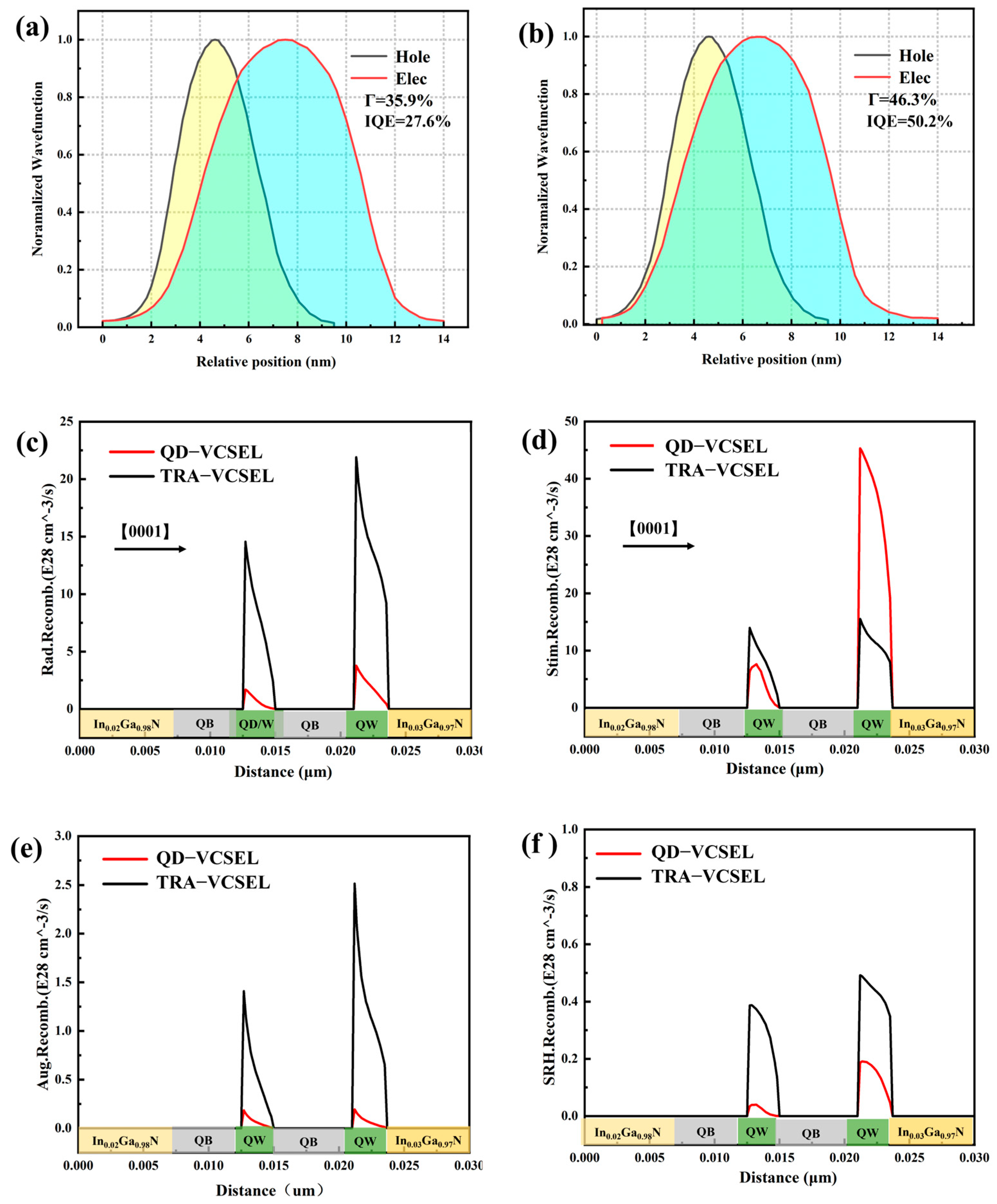
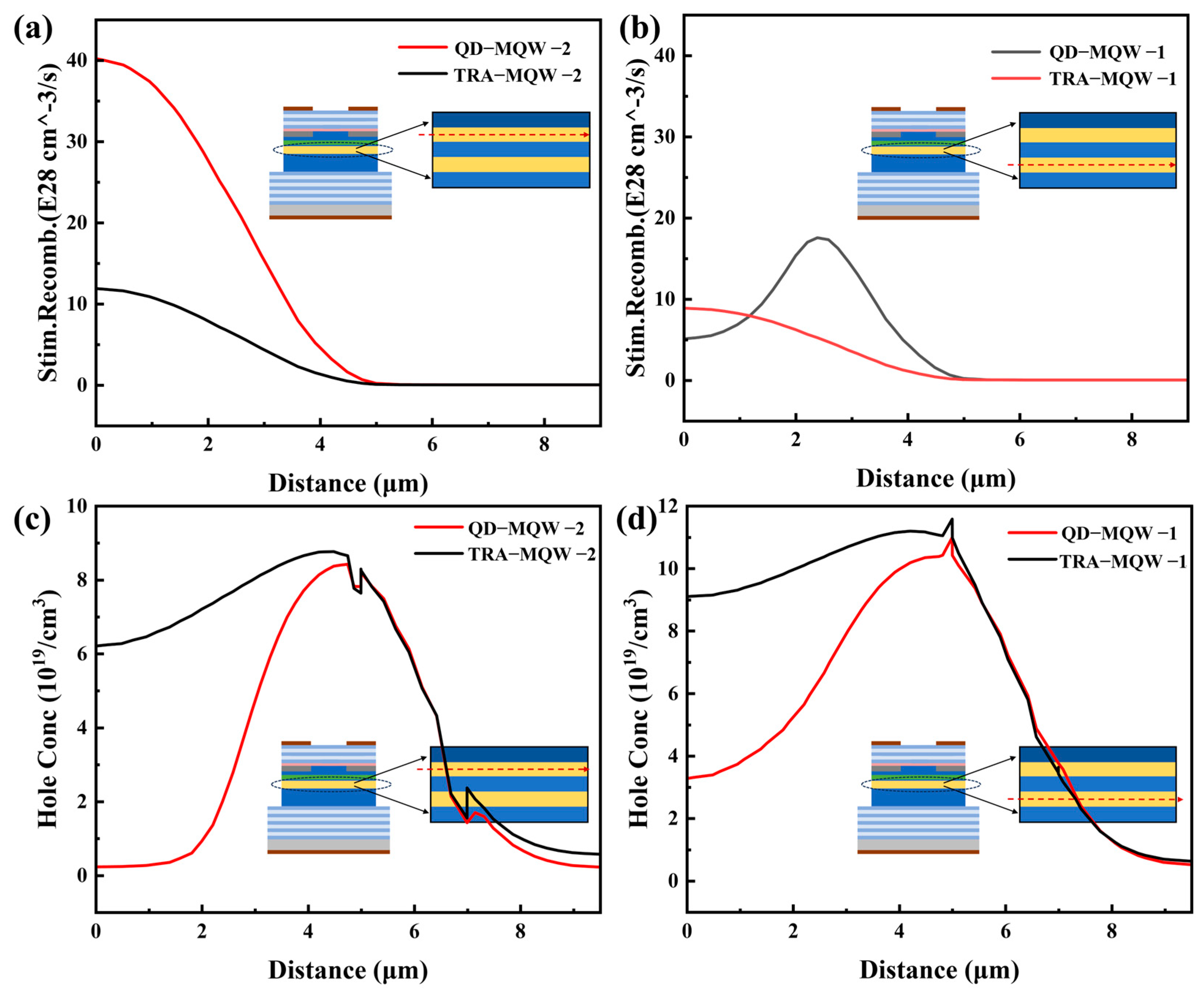
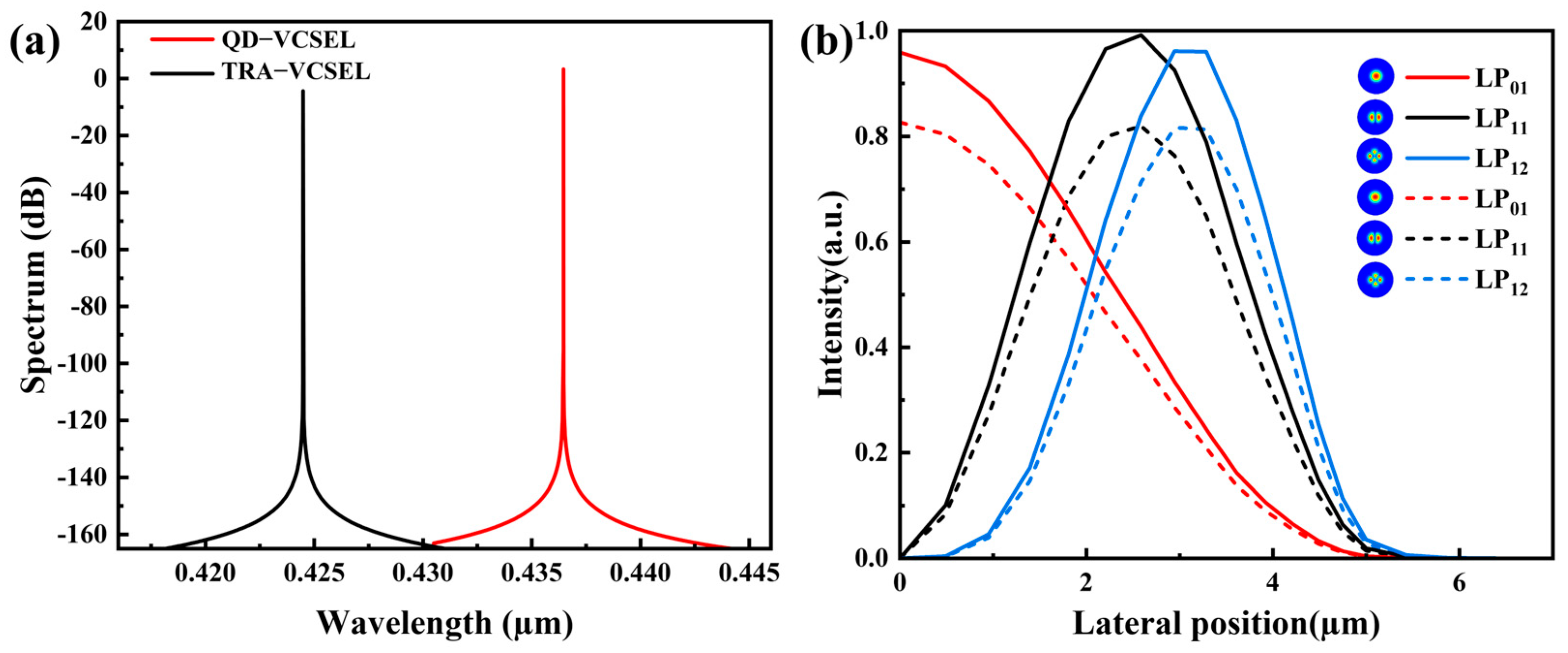
| Type | Material | Thickness (nm) | Doping Concentration (cm−3) |
|---|---|---|---|
| P-DBR | Ta2O5/SiO2 | 1556.4 | |
| Current spreading layer | ITO | 20 | |
| P-GaN | GaN | 476 | p:4e23 |
| EBL | Al0.2Ga0.8N | 20 | p:1e24 |
| MQWs | In0.16Ga0.84N/GaN | (2.5/6) × 2 pairs | |
| QD | In0.23Ga0.77N | 1 | |
| Layer wrapper | In0.16Ga0.84N | 0.75 | |
| N-GaN | GaN | 1900 | n:2.5e24 |
| N-DBR | Ta2O5/SiO2 | 1297 |
| Parameter | Value |
|---|---|
| Auger recombination coefficient (m6/s) | 1.4 × 10−43 |
| Lifetime (e/s) | 1 × 10−8 |
| Polarizability % | 40 |
| InGaN/GaN conduction band step/valence band step ratio | 70/30 |
| AlGaN/GaN conduction band step/valence band step ratio | 50/50 |
| Average optical loss outside active area (m−1) | 1000 |
| Parameter | Value |
|---|---|
| Period (nm) | 10 |
| Height (nm) | 1 |
| Width (nm) | 2 |
| GaN base layer wrapper (nm) | 6 |
| In0.16Ga0.84N-well layer wrapper (nm) | 0.75 |
Disclaimer/Publisher’s Note: The statements, opinions and data contained in all publications are solely those of the individual author(s) and contributor(s) and not of MDPI and/or the editor(s). MDPI and/or the editor(s) disclaim responsibility for any injury to people or property resulting from any ideas, methods, instructions or products referred to in the content. |
© 2025 by the authors. Licensee MDPI, Basel, Switzerland. This article is an open access article distributed under the terms and conditions of the Creative Commons Attribution (CC BY) license (https://creativecommons.org/licenses/by/4.0/).
Share and Cite
Hua, Z.; Dong, H.; Jia, Z.; Jia, W.; Shang, L.; Xu, B. Quantum-Well-Embedded InGaN Quantum Dot Vertical-Cavity Surface-Emitting Laser and Its Photoelectric Performance. Photonics 2025, 12, 276. https://doi.org/10.3390/photonics12030276
Hua Z, Dong H, Jia Z, Jia W, Shang L, Xu B. Quantum-Well-Embedded InGaN Quantum Dot Vertical-Cavity Surface-Emitting Laser and Its Photoelectric Performance. Photonics. 2025; 12(3):276. https://doi.org/10.3390/photonics12030276
Chicago/Turabian StyleHua, Zinan, Hailiang Dong, Zhigang Jia, Wei Jia, Lin Shang, and Bingshe Xu. 2025. "Quantum-Well-Embedded InGaN Quantum Dot Vertical-Cavity Surface-Emitting Laser and Its Photoelectric Performance" Photonics 12, no. 3: 276. https://doi.org/10.3390/photonics12030276
APA StyleHua, Z., Dong, H., Jia, Z., Jia, W., Shang, L., & Xu, B. (2025). Quantum-Well-Embedded InGaN Quantum Dot Vertical-Cavity Surface-Emitting Laser and Its Photoelectric Performance. Photonics, 12(3), 276. https://doi.org/10.3390/photonics12030276





